Joan Crawford Protests: A Short History of 'New Yorker' Corrections
Joan Crawford Protests: A Short History of ‘New Yorker’ Corrections
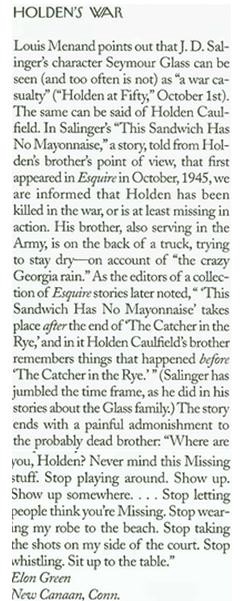
The New Yorker’s fact-checking department is singular. Unlike the few similar departments of other magazines, it’s got a bit of glam. People actually aspire to work there. And why not? How many fact-checking departments can claim to have been chronicled in the magazine’s own pages by John McPhee or depicted — for better or worse — in Bright Lights, Big City? It’s been at the top of the fact heap for years, at least in part for its absurd levels of rigor. As an editor noted not long ago, “Every quote, every detail, every attribution, every everything is checked for accuracy” — including the cartoons.
This obsessiveness, I can tell you from personal experience, extends even to the letters. Alongside is one of three missives the magazine saw fit to publish in the October 15, 2001 issue.
The fact-checker called within a week of the submission, unable to verify Salinger’s language. The Armchair Esquire, the anthology in which I’d found the story, wasn’t in the New Yorker’s library, and it would be several years before the story would appear online. I offered to fax him a copy, but such a remedy, said the fact-checker with resigned exasperation, was unacceptable. We went over each detail of my letter until, finally, the poor fellow was able to secure for himself a copy of the long-out-of-print book.
Despite such long-time safeguards — the New Yorker began fact-checking articles in 1927, after a disastrous profile of Edna St. Vincent Millay (see below) — the magazine does find that accidents happen. (It happens to the best of us, including those who may be oblivious to the multiple spellings of blowjob.) And to its credit, the magazine has a long history of airing its errors up front, smack dab in the letters section (update: yes, as well as throughout the magazine). For decades, the magazine gave a platform for readers, some famous, some not-so-famous, to vent about perceived wrongdoings or errors, under such headings as “We Stand Corrected,” “Department of Correction,” “Department of Correction and Amplification” and “Department of Correction, Amplification and Abuse.”
Here are some of the more notable.
COLE PORTER
Issue date: February 12, 1949
Geoffrey T. Hellman had written a Talk of the Town item in which he claimed that Porter — who was in town to record the cast album of “Kiss Me, Kate” — “regards most Yale graduates as colossal bores[.]”
Porter, Yale class of ’13 and a member of the Scroll and Key Society, was not amused.
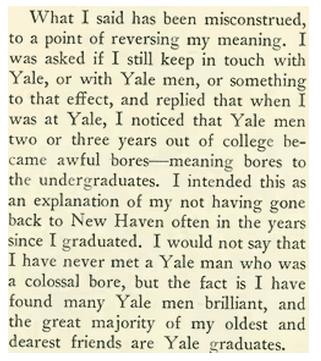
JOAN CRAWFORD
Issue date: May 2, 1942
Margaret Case Harriman opened her profile of Lilly Daché (“Hats Will Be Worn”, April 4, 1942) with an account of the ongoing strike among the fashion designer’s employees. “The strike has not perceptibly affected Daché’s business,” wrote Harriman. Indeed, she observed, just “the other day” Joan Crawford sent the doorman past the store’s picket line, after which “Mme. Daché had a dozen or so hats delivered to the car for inspection.”
Mommie dearest told a different story.
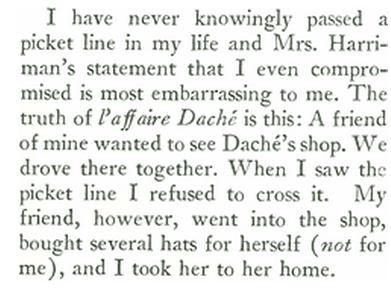
GROUCHO MARX
Issue date: February 2, 1929
Marx wrote to the editors of “your esteemed gazette” to say that New York governor Al Smith had, contra the New Yorker, recently seen five, not four, Broadway shows. Smith, insisted Marx, had been seen at Animal Crackers (which was a musical before it made the silver screen) and apparently was so taken he visited the Brothers backstage, “tears still coursing down his cheeks.”
“I’ll give you just twenty-four hours to retract that statement before I call on you and horse-whip you within four or five inches of your life,” wrote Marx.
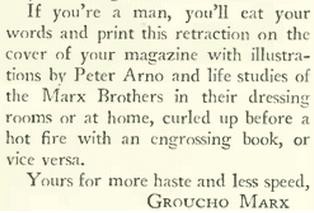
PETER HODGSON
Issue date: September 9, 1950
A “Talk of the Town” item concerned a hot new product called Silly Putty. The toy, which the New Yorker described as “a gooey, pinkish, repellent-looking commodity”, was “a perfect furniture leveler; you just stick some of it under the short leg of a jiggly table and there you are.”
Hodgson, Silly Putty’s developer, wasn’t pleased.
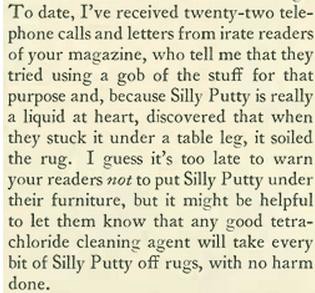
MARGARET MITCHELL
Issue date: June 5, 1937
In May, the New Yorker had quietly broken the news that Margaret Mitchell was planning a sequel to Gone with the Wind. Improbably, Mitchell had disclosed this information in a letter to “an old lady in Urbana.”
Mitchell quashed the rumor.
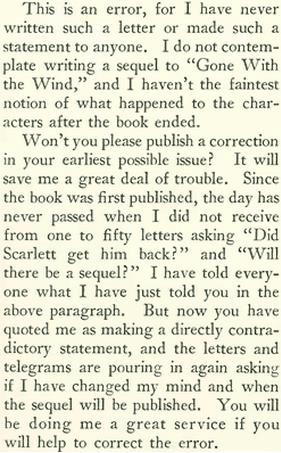
CORA MILLAY
Issue date: April 23, 1927
Edna St. Vincent Millay’s mother was furious that the February profile of her daughter by Griffin Barry contained so many mistakes. There were errors in biographical details, she said, as well as in the author’s assumptions: Barry had written that Mother Millay “appears to remember little of her own biography.”
“It might be that I am more loquacious at times than at other times, but my friends do not seem to think I am losing my memory,” she replied.
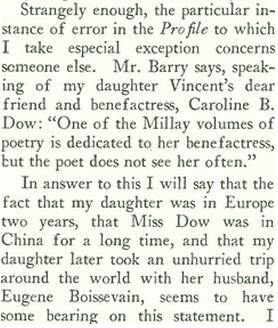
EVANGELINE ADAMS
Issue date: October 22, 1932
The renowned astrologer felt she’d been misquoted when the New Yorker claimed Adams had foreseen a victory by Herbert Hoover in the next election.
No “responsible astrologer would definitely ‘predict’ results of an election, or the ups and downs of the stock market.” Rather, said Adams:
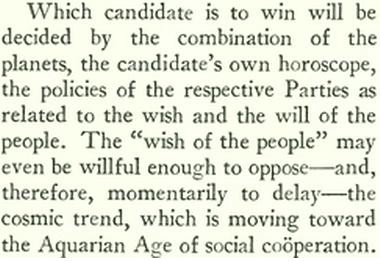
JAMES THURBER
Issue date: February 7, 1959
Thurber, by then on staff at the New Yorker for three decades, wrote in to correct an error of his own making. The previous November, he’d used a Latin expression in the first paragraph of his short story “Midnight at Tim’s Place”: Horas non numero sine serenas, which he translated as “I count serene hours only.”
A New Jersey high school student had written to Thurber, correcting the great man’s Latin, which should (apparently!) have been Horas non numero nisi serenas.
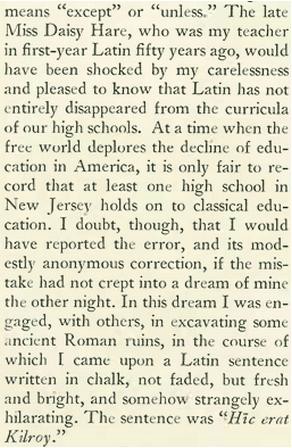
JOHN LYDENBERG
Issue date: May 31, 1947
An article about the New York Public Library’s Robert L. Stuart Collection by Geoffrey T. Hellman — him again! — included a quote from “the late” Harry M. Lydenberg, a former director of the library. Trouble is, wrote his son, Lydenberg père was very much alive.
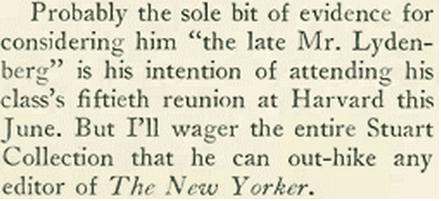
ROCKWELL KENT
Issue date: March 31, 1945
Rufus Jarman’s profile of Norman Rockwell revealed that a lot of Rockwell’s fan mail was misdirected to another artist, Rockwell Kent. Jarman quoted an article authored by Kent — the publication is unnamed — containing a bitter nod towards Kent’s contemporary. “I take my hat off to him, and so do ninety-nine people out of every hundred that I meet, east, west, south, north, who tell me they love his work.”
Kent didn’t dispute the quote; he simply wished the New Yorker hadn’t used it.
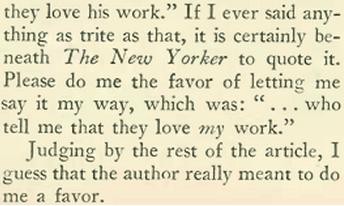
Elon Green writes supply-sider agitprop for ThinkProgress and Demos.
Previously: A Brief History Of The New Republic’s Various Stances On War
Demark Vessey, "Team Dirty Piss"
Detroit’s Denmark Vessey is not just good at catching beer bottles. He also writes and produces and raps rap music. His new song is sort of psychedelic heavy metal rap, with a video to match. Similarly weird and fascinating (actually, far weirder), Dave Tompkins, a leading authority on the weird and fascinating, writes about his experiences with the late graffiti/rap/art legend Rammellzee for the Paris Review.
Pleasant-Sounding Name Not Totally Accurate
Until just moments ago I had no idea what a “Manhattan-powdered doughnut” was, and now I pine for that more innocent period of my life.
How Not to Kiss in Paris

“In kissing, some people were ripe, others were not. Whole groups could be off-limits. It definitely wasn’t appropriate to kiss your boss, except when it was, though it was correct to kiss your underlings, except when it wasn’t. Young men generally didn’t kiss other young men, unless they were friends outside work. But older men did, sometimes. You never knew. Also, these kisses were intended not to touch the cheek but to glance it. People kept their eyes locked on the middle distance and seemed, while kissing or being kissed, very bored. Honestly, I had no idea how it worked. September found me frequently biseing inappropriately. Male clients, IT support workers, freelance temps. Any female who came within ten feet. They’d return my weird kisses reluctantly, or else back away and attempt to ignore the gaffe. I asked Pierre how he knew whom to kiss, whom not. Pierre said there was no way of knowing this unless you’d grown up in France, then you just knew. He himself preferred to shake hands. André overheard Pierre saying this and suggested, in that case, Pierre should move ‘the fuck’ back to New York.”
— Do you dream of moving to Paris? Think again. (An excerpt from Rosecrans Baldwin’s Paris, I Love You but You’re Bringing Me Down.)
30th Nightmarish Shark-Faced Drug Sub Scuttled!

“When reports first surfaced in the 1990s of boat builders making submarines for cocaine smugglers in the jungles of Colombia, U.S. law enforcement regarded them as a comic curiosity. Today, with the disclosure that the U.S. Coast Guard has intercepted its 30th semi-submersible in less than six years, the vessels are now seen as a troubling tactic.”
— Troubling indeed! These 30 drug subs are just the ones the Coasties and their allies have busted!
Murray Perahia Is 65
The immensely talented pianist Murray Perahia (his Goldberg Variations comes in at number six on our list) turns 65 today. I would recommend starting with Songs Without Words if you’re unfamiliar.
Old Man Dies
I don’t have a lot of feelings about Dick Clark (maybe I should!), expect to feel like now that he’s passed New Year’s Eve will be a bit less awkward for everyone. I talked to my mom — who is of the generation who watched him as kids — last night, and she was all, “Well, it’s not good,” but, you know, when Pat Boone finally kicks off I don’t imagine I am going to have much of a reaction either. (Pat Boone was still alive as of the time I put this in the hopper.) Because I’m not THAT old. It’s a weird reminder of our three network era in which everyone had the same references all the time. Unless you were poor. But that was a while ago, I guess. In any event, if you want a decent obituary for America’s oldest teenager, head here.
The Tribeca Film Festival's New Artistic Director Made a Career Of Watching Movies
by Noah Davis

The Tribeca Film Festival starts today, and at its helm this year is Frédéric Boyer, who is something of an accidental artistic director. All the Parisian ever wanted to do was watch films. He even skipped his schoolboy exams to screen a flick. That obsession — viewing five, six, seven movies a day — led to a job at Videosphere, the Paris store with over 60,000 titles, which in turn resulted in a gig programming the Directors’ Fortnight in Cannes. Now, he finds himself programming the New York festival. The career path is accidental, perhaps, but he’s hardly unprepared. “It’s the life I choose because I don’t want my work to stop at 6:30 p.m. I just want the work to be in my life and my life to be in my work. It’s what I like,” he told me when we met for coffee last week at one of his favorite cafes in (yes) TriBeCa.
Noah Davis: I thought it was interesting that you had never been to the Tribeca Film Festival because of Cannes.
Frédéric Boyer: You can’t. There is so much preparation for Cannes. I was invited and I know Tribeca from the beginning. I know David [Earls, director of development] and Peter [Downing, operations director] very well. The filmmakers and producers say that this is the best audience in the world. For me, it’s great. I came from the Director’s Fortnight, which is a sidebar dedicated to art house film and the filmmakers. Here, it is the same. But it is larger and there is a total devotion to the filmmakers, which I love.
Is Tribeca more for the people than some other film festivals?
Yes. I think the Tribeca Film Festival is a popular film festival, in a good way. From the opening to the small documentary made in Romania, it’s for every audience and every community. The idea is not to choose a film for a community. The idea is to choose a film and the community will come. It’s not a good thing to program for the community, the place, or the market. If you have a good review or if the film can be sold, great. If the community is coming, fantastic, but the best is to choose quality films.
What do you do on a day-to-day basis? Are you watching films all the time?
My job is watching but not only. People ask me how many films I watch a year. I watch a lot, but the number is not an extremely interesting question. [Editor’s note: He watches around 1,000 films a year.] I judge a film. To judge a film is to know what is a good film, not to choose the film you love. I love melodrama. I can choose 10 melodrama, but you need to fit films into the program. Geoff [Gilmore, chief creative officer] and I love the films we are programming, but the quality is the most important. Programming is like editing. It’s like building a menu. You have a starter, an entree, dessert. You have everything in a festival.
My job is not only watching film. The most interesting part will be in June, July, and August when I meet the filmmakers, read scripts, and talk to the technicians, the producers, and the directors of photography. [I want to] follow the project and know that if a film is finishing shooting in September, it could be ready for us. The idea is to say “We can premiere your film in Tribeca,” if we like it.
The first week of June, I will be in Tel Aviv on the jury of the biggest student film festival in the world. I didn’t know the festival but it’s fantastic to meet the people from the film school. I will go because I’m working for Tribeca, but also for me. I just want to meet them. I want to say, “I’m here. I’m looking at your film. I’m respecting what you’re doing.”
Meeting the filmmakers is the most interesting part to me. Especially the filmmakers who are premiering here for the first time. The mother, the father, the brother, everybody will be here. It is something so beautiful. It is extremely important to support them.
It seems like you love film….
….Yes!
Which is kind of a stupid statement to make, but your bio is full of film-related jobs that aren’t necessarily festival-related. Did you plan to be an artistic director?
Never. It was a surprise. During the time I was working at Videosphere, I was in Turkey at a wedding and my friend called me. He asked if I wanted to be the head programmer for the Fortnight. It was a surprise. When Olivier left for Thévenin;, I thought why not try to be artistic director? I had a few interviews and I had 90 percent of the votes. It was a surprise. I think they wanted someone who wasn’t a critic.
Do you think that gives you a different perspective?
I think so. I was always totally independent. I never worked in any television channel or anything. I’m just a cinephile. A long time someone asked Jean-Luc Godard if he had any children. He said he could not have children because he was doing films. It was the same for me at the beginning. It was impossible to have children or any love affair because my priority was to watch films. It was a wonderful period because it was a crazy period. I was watching five, six, seven films each day and reading books about cinema. Fortunately, I escaped from this beautiful prison because of music, women, wine, food, life. You cannot be a perfect cinephile if you are not connected with life and politics. I love politics. I’m following the Obama campaign and the Sarkozy campaign. You can have a point of view about artistic things, about cinema, but it’s not enough. You should be in life. But also love movies.
How do you like New York?
I love it. For a cinephile, it’s fantastic because every street reminds you of something. That is totally different. When filmmakers shoot Paris, it’s not working. They have to sell the film so, for example, they have to shoot the Eiffel Tower and the Seine, which is beautiful, but all the Parisians are not living in these famous places. And you are not living in Central Park.
It must be nice that Tribeca is about to start.
We are excited. We spent a week or 10 days before the storm watching the films again to decide what we’re going to introduce and everything, but my work is done now.
Now you just hang out at coffee shops?
[Laughs] Exactly. But you know, Cannes was fantastic, but it was only 20 films. My work was to say no all the time. It was frustrating. Here is much more open.
What do you want to do next in the film world?
Producing film is something that is extremely interesting to me because it’s extremely artistic. When I’m following the project, I mostly follow the producers. There are more and more producers, especially women. Female producer are young, different, thinking more about the storyline and storytelling. And it’s great.
Noah Davis is frequently lost. He tweets here.
Wow, That Is A Lot Of Stuff To Read
The 2011 edition of Conor Friedersdorf’s list of the year’s best journalism is out, and a few of the selections might be familiar to you. Or not! But don’t say you don’t have anything to read now.
Dog And Monkey Frolic About, Unencumbered By The Awkwardness That So Often Complicates...
Dog And Monkey Frolic About, Unencumbered By The Awkwardness That So Often Complicates Relationships Between Different Types Of Being
Please enjoy this heartwarming tale of interspecies communication that should serve as a valuable lesson to all of us on how to focus on our similarities rather than the things that set us apart. If that’s not enough for you there’s a squirrel eating a rose below.
